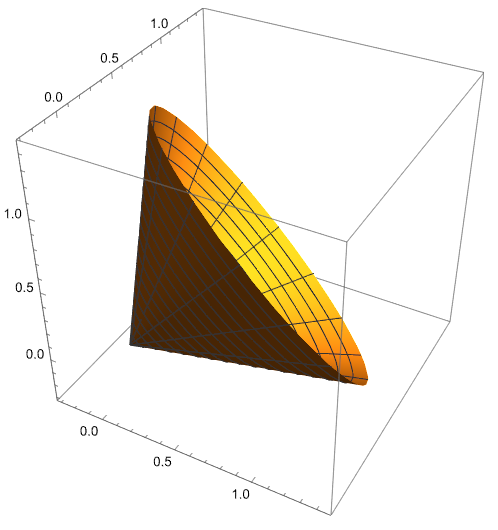It remains to show that $S_u\not\subseteq\R_+^d$ for any unit vector $u$. Take indeed any such vector $u=(u_1,\dots,u_d)$. Without loss of generality, $|u_1|$ is the smallest of all the $|u_j|$'s, so that $$|u_1|-\sqrt{1-u_1^2}<0.$$ Let now $$v=v^*:=(v_1,\dots,v_d):=\Big(-\sqrt{1-u_1^2},\frac{u_1u_2}{\sqrt{1-u_1^2}},\dots,\frac{u_1u_d}{\sqrt{1-u_1^2}}\Big). \tag{1}\label{1}$$\begin{equation} v=v^* :=(v_1,\dots,v_d):=\Big(-\sqrt{1-u_1^2},\frac{u_1u_2}{\sqrt{1-u_1^2}},\dots,\frac{u_1u_d}{\sqrt{1-u_1^2}}\Big). \tag{15}\label{15} \end{equation} Then $u+v\in S_u$. However, $u_1+v_1<0$, so that $S_u\not\subseteq\R_+^d$. $\quad\Box$
Added: Since the OP wanted an explicit finite set of vectors (rather than the infinite set $S_u$), let us provide such a set. So, for $d=3$, let $S_{u,N}$ be the set of all $N$ vertices of a regular $N$-gon inscribed into the circle $S_u$. Then the shortest distance from the point $v^*$ defined in \eqref{115} (and actually from any point on the circle $S_u$) to the set $S_{u,N}$ will be no greater than the length $2\sin\frac{2\pi}{4N}$ of a side of a regular $2N$-gon inscribed into the unit circle $S_u$. So, following lines of above reasoning, we see that, to get $w_1<0$ for at least one vertex $w=(w_1,\dots,w_3)$ of $S_{u,N}$, it is enough that $\frac1{\sqrt3}-\sqrt{1-(\frac1{\sqrt3})^2}+2\sin\frac{2\pi}{4N}<0$. The latter inequality holds for all natural $N\ge14$. Thus, we get a counterexample with a set of $14$ vectors. This is worse than $N=5$ in Nathaniel Johnston's answer; however, here the reasoning is quite elementary. (The number $N=14$ can apparently be improved even within this elementary framework, using a bit more complicated consideration.)
Details on the update: As in the paragraph just above, let $d=3$ and consider the set $S_{u,4}$, that is, the set $S_{u,N}$ with $N=4$, so that $S_{u,4}$ is the set of the vertices of a square inscribed into the circle $S_u$, defined in \eqref{10}. So, \begin{equation*} S_{u,4}=\{u+V_j\colon j\in\{0,1,2,3\}\}, \end{equation*} where \begin{equation*} V_j:=a\cos\Big(t+\frac{2\pi j}4\Big)+b\sin\Big(t+\frac{2\pi j}4\Big)=(V_{j,1},V_{j,2},V_{j,3})\in\R^3, \end{equation*} $t\in[0,\pi/2]$ is the angle of the rotation of the vertices of the square about the axis through the vector $u$, and $u,a,b$ are orthonormal vectors in $\R^3$. To be specific, let \begin{equation*} a=\Big(\sqrt{1-u_1^2},-\frac{u_1u_2}{\sqrt{1-u_1^2}},-\frac{u_1 \sqrt{1-u_1^2-u_2^2}}{\sqrt{1-u_1{}^2}}\Big) \end{equation*} and \begin{equation*} b=\Big(0,\frac{\sqrt{1-u_1^2-u_2^2}}{\sqrt{1-u_1^2}},-\frac {u_2}{\sqrt{1-u_1^2}}\Big), \end{equation*} with \begin{equation*} u=(u_1,u_2,u_3). \end{equation*} Here it is assumed that $u_1^2\ne1$, which can be done without loss of generality (wlog) -- otherwise, rearrange the coordinate axes.
Without loss of generality (wlog)Wlog, \begin{equation*} u_1\le u_2\le u_3. \end{equation*}

